Blog
Meet an Adventuress: Tessa Hulls
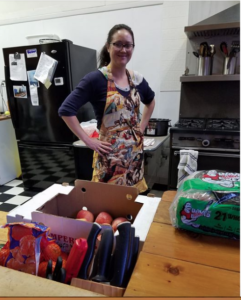 Tessa Hulls is a multi-talented writer, illustrator and artist, chef, and all-around adventuress. During 2017, she was a volunteer chef for Mineral School during our October parent artists’ residency. A nomadic artist who spends her time in The Arctic and Alaska not to mention Washington state, we were grateful to her for sharing her cooking skills as well as sharing from her graphic memoir in progress — a layered story about the legacy of her Chinese grandmother Sun Yi. We’re grateful to her volunteer spirit and adventurous approach to life. Author Kait Heacock conducted this interview.
Tessa Hulls is a multi-talented writer, illustrator and artist, chef, and all-around adventuress. During 2017, she was a volunteer chef for Mineral School during our October parent artists’ residency. A nomadic artist who spends her time in The Arctic and Alaska not to mention Washington state, we were grateful to her for sharing her cooking skills as well as sharing from her graphic memoir in progress — a layered story about the legacy of her Chinese grandmother Sun Yi. We’re grateful to her volunteer spirit and adventurous approach to life. Author Kait Heacock conducted this interview.
Tell us about your current project and its inspiration. What’s the process for writing your graphic memoir and where are you currently in the process?
The CliffsNotes version is: I’m working on a nonfiction graphic novel exploring loss of culture, mental illness, generational inheritance of trauma, mixed race identity, mother/daughter relationships, loss of language, and the American fascination with the frontier as told through the life story of my Chinese grandmother, Sun Yi.
Sun Yi was a j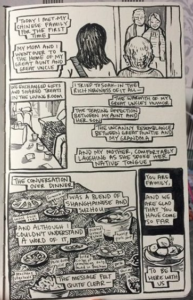 ournalist in Shanghai and in 1949, the year of the Communist takeover, she had an affair with a Swiss diplomat and ended up a single mother raising a mixed race bastard child while being persecuted by the Communist government. In 1958, she smuggled herself and my then-seven-year-old mother out of the country by hiding them beneath the false bottom of a fishing boat, and they fled to Hong Kong where my grandmother wrote a memoir—Eight Years in Red Shanghai: Love, Starvation, Persecution—that became a national bestseller in Hong Kong and Taiwan.
ournalist in Shanghai and in 1949, the year of the Communist takeover, she had an affair with a Swiss diplomat and ended up a single mother raising a mixed race bastard child while being persecuted by the Communist government. In 1958, she smuggled herself and my then-seven-year-old mother out of the country by hiding them beneath the false bottom of a fishing boat, and they fled to Hong Kong where my grandmother wrote a memoir—Eight Years in Red Shanghai: Love, Starvation, Persecution—that became a national bestseller in Hong Kong and Taiwan.
My grandmother used the money from her book to place my mom in an elite Hong Kong boarding school, which is where my mother learned English. Once my mother was safe, Sun Yi’s struggles with mental illness came to a head and she had a mental breakdown and was institutionalized; she never truly recovered. And so my mother—who never met her father— was essentially raised as an orphan by her boarding school, and she spent her entire life taking care of her own mentally ill mother until Sun Yi passed away in 2012. My mother eventually got a college scholarship to come the US and brought Sun Yi over, and I grew up with my grandma living within my nuclear family. She and my mother communicated solely in Shanghainese, which they never taught me to speak, so between the language barrier and my grandmother’s mental state, I was never able to know her as a person, only as the broken ghost of a culture I didn’t understand.
I was raised by the negative space of an absent culture, and it wasn’t until I was in my late twenties that I really started to see how much of the fraught, agonized relationship between myself and my own mother was rooted in the fact that I was American and she was Chinese. This graphic novel is my attempt to be a prodigal daughter/granddaughter, and I hope that by telling the story of my mother and grandmother’s tragic pasts, I might be able to bring some peace to all of us in the present.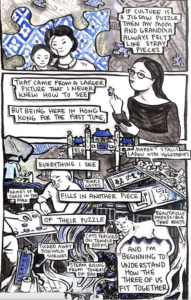
This project is intensely research-heavy and has already involved international travel and translation across four languages, so although I’ve been working on it for two years, I foresee at least three more. In 2015, I received a grant to have my grandmother’s memoir translated into English and was thus able to “hear” her voice for the first time, and in 2016, I went on a grant-funded research trip to Hong Kong and China for two months and finally met my Chinese family. I’m hoping to spend a few months in Shanghai conducting the last of my on-the-ground research, and will then just be in hiding making this behemoth.
In terms of process, I’m writing the whole thing first before I do any drawing in order to make sure I have the structure and narrative arc nailed down. While I hammer out the outline, I’m doing all the necessary historical research to be able to convincingly draw 1950’s Shanghai and 1960’s/70’s Hong Kong. I’ve gone through my grandmother’s memoir and made a list of every object she mentions: she writes about sitting on a couch? Well then I need to know about 1950’s Chinese furniture. She writes about a government Cadre holding a gun to her chest? Then I have to figure out what gun was standard issue for mid-level Communist Party members in 1954. With writing, you can effectively set a scene without giving these visual details, but with drawing, there is an entirely different level of world-building: you need to know what each of these things truly looks like.
So yeah, it’s going to take me a while…
How many projects do you tend to work on at one time? How do you switch gears betwe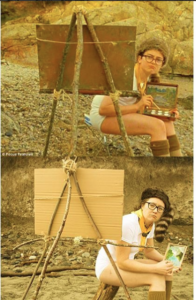 en mediums?
en mediums?
I’m never sure how many things I’m working on (at right she imitates a scene from “Moonrise Kingdom”), but I’ve come to trust that my subconscious eventually lets me in on what it’s been doing when it comes time to shift from ruminating to producing. It’s a bit like overseeing a mine—I have an unknown number of miners down there busily chipping away at things, and when one comes up to the surface, I work with whatever raw ore it brings me.
That segues nicely into your second question: I am often as surprised as the next person by what my miners have been extracting, and the raw material dictates the medium I work in. There’s never a point at which I deliberately say, “And now I shall focus on painting for six months!” Instead, it’s that I’m brought word-ore, so it has to be refined into writing.
I do notice that my medium-focuses tend to come in clumps, almost like the miners have hit a good vein of word-material, and so I’ll mostly write until the miners come across a band of illustrated-performance-piece rock. Sorry, I really like protracted metaphors…
Where can people find your work? Are you showing anywhere in Seattle right now?

I’m pretty deliberately trying to both hide and keep my schedule open so I can focus on my graphic novel, but I do have a few things I’m working on. I’m writing an ongoing series of essays about badass women in history for Atlas Obscura’s Kickass Women series, and have shared the stories of the circus strongwomen, Arctic survivalists, and backcountry Alaskan hunters/chefs who serve as my personal heroes.
I also have a series of interview-based portraits of Asian American elders on display in Seattle through early February (see image at left). On March 4th, I’ll be giving a talk titled “Fucking the Patriarchy” at the Turn of the Century: Strong Women in the Early 1900’s for a new speaker series called the Academy of Research and Wonder.
Has anything at Mineral Lake inspired you to draw/paint/write about it?
Obliquely, yes: I treated my time at Mineral School as a personal mountain biking retreat and spent a lot of time getting deliberately lost out on the area’s logging roads, and all of that quiet mileage definitely soaked in. I will likely never directly draw or write about those landscapes that I saw, but they inform my process, which amounts to the same thing in the end.
Which statement rings truer: wanderlust affects my art or art affects my wanderlust? And why?
Gah! That’s not fair, I can’t separate those two statements. I will always need to wander, and I will always need to make art, and I need the two in order to both understand and justify one another. Sometimes I feel like I’m a Siamese twin in that I made it to adulthood with two fully-formed selves—but we share internal organs that can’t quite support us both, and so we have to take turns swapping between who is getting full use of the lungs and stomach and spleen. Sometimes art-self has to be a bit starved so wanderlust-self can be fully nurtured, and when one of my twins starts to tell me that she’s struggling to breathe, I swap back. It’s not the most comfortable relationship, but it’s also something I feel like I have very little control over, and I have—mostly—learned to just accept that I need to live in this state of actively maintained equilibrium.
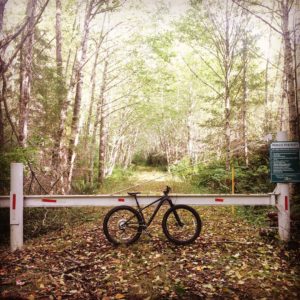
What is home? Where is home?
Earlier this year, I went on a really fun date involving shooting beer cans in a quarry with .22’s, and while there was a mutual lack of romantic interest, I am totally stealing that guy’s response to the question What is home? (yeah, I am the sort of person who asks that on a first date): “Home is where you can feel grateful from.” Home is definitely not a concrete place, and I’ve embraced that, at least for me, it’s a moving target that I need to literally chase. The older I get, the more I am convinced that home is spending all day outside and then sharing a meal with close friends while wearing warm, dry socks.
I’d also like to answer this question by just telling you to read Wayfarer’s All, the ninth chapter of The Wind in the Willows. It perfectly articulates what it means to be a migratory creature, and how the pull towards home physically tugs at you as the seasons shift.
What’s in Alaska?
Silence, an unharried relationship with time, an intimate connection to landscape, the ability to disconnect from technology, an intact sense of community, a paradoxical embracement of interdependence coupled with fierce self reliance—I started working seasonally in Alaska six years ago, and it holds my love in a way that nowhere else does. Modern society asks us to live at a ceaseless sprint, and for part of the year, I’m willing to do that. But I need long breaks, and Alaska provides those for me. One of my favorite Calvin and Hobbes strips talks about how the trouble with tigers is that there’s no setting between high and off, and as someone who is very much wired that way, I need Alaska in order to provide enforced rest; it’s where I do all of my thinking so that I can come back ready to make.




